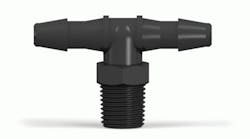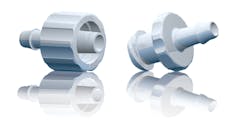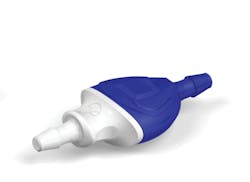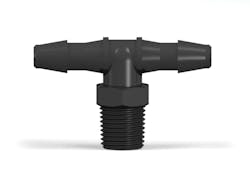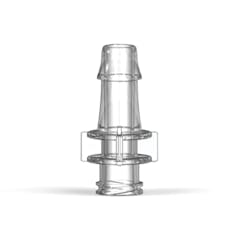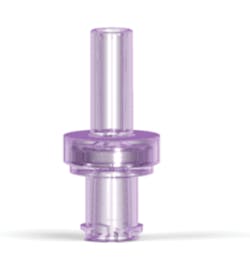Industrial and laboratory OEM designers are constantly being challenged to come up with more versatile, user-friendly, light weight and cost-effective product solutions for their equipment and instrumentation. An important component in this design process is the selection of tubing connectors for the transfer and management of compressed air and other fluids, particularly for mission-critical applications.
Although metal tubing connectors have been traditionally employed in industrial and laboratory markets, plastic connectors continue to supplant many that were previously metal — not only because of their increased options for design flexibility, improved ergonomics, reduced weight and lower cost, but also for their ability to effectively meet stringent industry standards in diverse and harsh environments. Many features of plastic connectors, which have been long proven in critical medical equipment design, are now being integrated into a broad spectrum of industrial equipment and laboratory instrumentation.
But choosing the right plastic connector can be a challenge. Plastic connectors offer more options for material selection, user interface and customized design than metal connectors. A basic understanding of the options available with plastic connectors will help the OEM to specify the most optimized features to achieve peak performance in the equipment or instrument being designed.
Application driven
Although plastic connectors effectively fill many roles, they may not be suitable for all laboratory and industrial uses. Brass, aluminum, die-cast zinc and stainless steel connectors are designed for extreme durability, particularly when influenced by high pressures and high temperatures. Choosing the best suited connector first requires a careful assessment of the application. Primary factors to consider are:
Temperature range — the minimum and maximum temperature tolerances that the connectors will need to function within. Depending on connector material, temperature tolerances can range from -40° to 200°F and above.
Pressure range — determining the minimum, maximum and working pressures that the connectors will be expected to tolerate.
Flow rate — assessing the required volume per minute, and the effect of pressure pulsation, and modulations from connect and disconnect forces.
Media — although compressed air poses no special challenge for plastic fittings, the external environment can pose a tremendous threat. Exposure to sunlight and artificial sources of ultraviolet light, wind, dust, vibration, radiation, gases, water submersion, chemicals or cleaning agents, and mechanical stress can all be detrimental.
Specialized environments — for food and pharmaceutical grade manufacturing, including wash-down, cleanroom and aseptic environments, and vacuums.
User interface — level of human contact expected with the system and connectors.
Cycle life — anticipated maintenance and changeability required to be performed on the system, and expected longevity of the system in operation.
The requirements of the application will then determine what materials would be best suited for the connectors.
Connector materials
The material chosen for plastic connectors should be based on the mechanical requirements of the connector and the type of media that will be moving through the system. Significant advantages and disadvantages need to be weighed in the selection of connector material. Mechanical properties, such as toughness, ductility, impact strength, transparency, lubricity, temperature capability, ozone resistance, and UV compatibility need to be assessed when selecting the most functional material for the application.
Careful consideration needs to be addressed to chemical compatibility and the most appropriate plastic resin for the application. Made of high-purity resin materials for use with aggressive chemicals found in most industrial and manufacturing plants, plastic connectors offer broad chemical compatibility. Many are manufactured from virgin resins, with accompanying certification of lot traceability.
A broad spectrum of plastic resins can be selected from to produce connectors, each with different characteristics to match the needs of system designers. These plastic resins are commonly used for producing connectors.
Polyethylene — chemically resistant, translucent or opaque thermoplastic with low temperature impact, which can withstand a variety of application environments.
Polycarbonate — hard, transparent thermoplastic with moderate chemical resistance. It provides good impact resistance and superior dimensional stability.
Polypropylene — soft thermoplastic that is highly resistant to chemical attack from solvents and chemicals in harsh environments.
Polyamide (nylon) — versatile thermoplastic with good wear and chemical resistance, low permeability to gases and performs well at elevated temperatures.
ABS — tough thermoplastic with good stiffness and impact resistance even at lower temperatures, as well as good dimensional stability and high temperature resistance.
Acetal — strong and lightweight thermoplastic that provides high strength and rigidity over a wide range of temperatures.
PTFE — fluoropolymer resistant to most chemicals and solvents, with stability at high temperatures.
PVDF — thermoplastic that is mechanically strong with good ductility over a broad temperature range, as well as having excellent chemical resistance.
After the most appropriate material for the production of the connector is determined, the type of connection that best suits the laboratory or industrial need can be assessed.
Connection options
Connectors are designed to accommodate tubing of varying hardness (durometer) — from soft and flexible like PVC and silicone, to semi-rigid types like polypropylene, polyethylene, polyurethane and ethylene vinyl acetate (EVA). To accommodate these varying styles of tubing and their respective application needs, different connector types are used, including barbed connectors, check valves, Luer connectors, quick-acting couplings, threaded luer fittings, and tube-to-tube connectors. Of these, the most commonly used tubing connectors are tube-to-tube connectors, Luer fittings, and quick-acting couplings. These basic connector styles can cover a wide range of liquid and air applications in laboratory and industrial environments.
Tube-to-tube connectors — a popular choice for applications that do not require the disconnection of equipment or parts at any point during production or use. Tubing connectors are available in many different configurations, sizes and material options to adapt different tube sizes or styles, reroute the flow direction without kinking, and act as a manifold.
Luer connectors — delivery systems can employ conical or taper seal connectors, called Luers, to link various system components. The male and female components of Luer connectors join together to create secure, yet detachable, leak-proof connections with no O-ring or gasket required. Luer connectors come in a variety of configurations adapting to tube connections, threaded connections (UNF, NPT and metric) and other Luer or quick coupling terminations. Some of those incorporate a tapered UNF thread, similar to a pipe thread, which can also seal on the thread due to interference on the pitch diameter, facilitating directional alignment with tees and elbows.
Quick-acting couplings — allow flexible tubing and equipment to be quickly and safely connected and disconnected. They may be preferred over general connectors for fluid control because they can incorporate built-in shut-off valves that prevent spillage, allow multiple disconnections and faster servicing.
Many of the latest quick coupling designs focus on the user interface and are equipped with intuitively simplistic thumb latch and side latch mechanisms to make handling easier in laboratory and industrial applications. Quick couplings mitigate the prospect of accidental misconnections and create quicker and safer device connections.
Barbs
Plastic barb-style connectors provide designers with a capability to accommodate the widest possible range of tubing properties and application conditions, including a multitude of configurations such as tees, wyes, elbows, and manifolds. Several barb designs are available — each with unique characteristics to tailor connection performance to specific needs — for handling assembly forces, tensile resistance and blow-off resistance without the need for clamps.
Barbs derive their holding capability by expanding tubing above its nominal inside diameter, creating some amount of interference for a secure seal and good mechanical retention. The tube expansion can vary dramatically, from lower profile, easier connections to much more aggressive interferences, depending on the pressure and tensile pull requirements.
The selection of the proper barb style is essential to the connector’s tube holding capability. The cylindrical surface behind the barb should allow the tubing to relax against the connector. In choosing a barb style, the barb chosen should be designed with a sharp peak, allowing it to “bite” into the tubing for optimal retention.
Quick coupling is ideal for lab work
A versatile new plastic quick-acting coupling available for laboratory and industrial applications is the MQC Series, manufactured by Value Plastics. The MQC Series provides an intuitive push-to-connect design. Large, ergonomic buttons provide an audible click on connection and grips for easy handling with gloves. Combined with a wide selection of color-coding options, the MQC is designed for ease of handling and to prevent poor connections.
Many plastic connectors and almost all metal connectors use multi-barb surfaces, which usually produce an inferior tube connection and seal. Multi-barbs cannot create a sharp bite on the tube, which inhibits retention. Also, they do not allow the tube a chance to relax behind the barb, resulting in poor tensile pull strength. Multi-barbs are also relegated to a manufacturing process that leaves a parting line on the sealing surface, creating a potential leak path.
This is an inherent design flaw, yet all multi-barb connector designs, including metal connectors, display this liability. In fact, poor quality single-barb plastic connectors are also afflicted with a parting line, reducing the efficacy of the connector. A well designed and properly manufactured connector will incorporate a singular barb with no parting line, a sharp bite, and a clean sealing surface.
Design optimization
Many factors can reduce the tubing’s ability to perform under pressure including temperature, chemical degradation, mechanical stress, pressure pulsation, selection of connector type and barb design. The latest generation of plastic connector technology affords designers and manufacturers a wide latitude of flexibility to design and set up applications that custom fit to their specific needs. Some connector manufacturers, such Value Plastics, provide comprehensive design centers to help instrumentation and equipment manufacturers achieve the highest level of performance from their connectors. With good consultation up front on the designer’s application requirements and prospective off the shelf or custom solutions, the pitfalls can be avoided and optimal designs can be executed.
Benefits
Compared to metal, plastic connectors provide a considerable reduction in weight and improved flexibility with regard to the equipment they serve. Also, plastic quick couplings allow rapid and easy servicing and maintenance of assembly line equipment, filling, and packaging systems to limit system downtime and speed throughput. Color-coding on plastic connectors also makes for quick tube identification and reconnection.
The cost difference between metal and plastic connectors is a major motivating factor pushing instrumentation, equipment, and system designers to further embrace plastic connectors in laboratory and industrial applications. Plastic connectors, particularly when custom designed for the application, are more frequently becoming the preferred solution in industrial and laboratory settings, due to their overall proven efficacy.
Riley Phipps is technical and design services manager at Value Plastics Inc., Fort Collins, Colo.
Value Plastics is now part of Nordson Medical, Loveland, Colo. For more information call (888) (970) -267-5299 or visit www.nordsonmedical.com.
